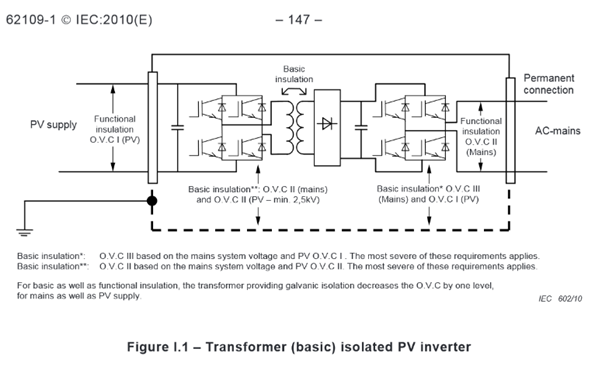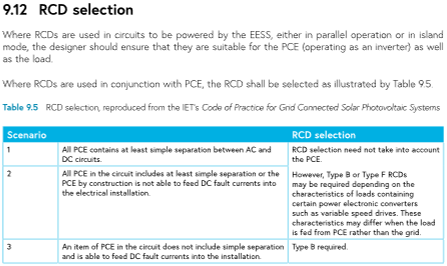I had an email this morning from the IET telling me that a Draft for Public Consultation has been published for Amendment 3 to BS 7671.
Details here electrical.theiet.org/.../
JP
I had an email this morning from the IET telling me that a Draft for Public Consultation has been published for Amendment 3 to BS 7671.
Details here electrical.theiet.org/.../
JP
For anyone interested in this discussion.
I would strongly recommend watching Mark Allison's Renewables Podcast with guests gkenyon and Michael Peace
It's 90 minutes but Graham gives a tour of the whole standards process - including BS 0. Michael gives specific technical explanations of the issue at play in this ammendment.
I have to say I think this kind of discussion is really useful. I think the best way to do these things in engineering is through consultation - which in my view needs to involve engineers being challenging each other in a professional way.
Here's the link to the podcast.
I found it educational and informative. I think that FE colleges could show this to their electrical learners.
I think that FE colleges could show this to their electrical learners.
That's a really good idea. It's probably technically outside the curriculum, and it often gets pointed out to me that FE isn't HE so the kind of seminars we used to have at university might not seem appropriate. But I think electricians should be able to discuss the deeper meaning to the regs and argue about them in an objective way - and feel confident putting in comments to these kinds of consultations.
In days gone by there was a deference to authority - an assumption that people who make the regulations are almost omnipotent and always know best. Which clearly can't be the case because JPEL/64 don't have a crystal ball, and in any case it’s a working document – this AMD 3 won’t be the last word and the next corrigendum/ammendment/edition is as inevitable as death and taxes. Also - contrary to popular opinion - the regs aren't telling people what they can and can't do. They provide a comprehensive and accepted way to design, erect and verify an electrical installation so that it's safe and functions properly for whatever it's intended use might be.
I think what's maybe lacking in the curriculum therefore is how Part 1 is taught - in my experience it's rushed past when it's actually the part of the regs upon which the entire rest of the document is hung. If we’re ever in doubt about the meaning of any provision in BS 7671 – or any standard – then the scope and objects should always form a key part of how you reach a reasonable interpretation.
Why not just make the next one Amendment 4? No need to re-write the whole book and charge people.
Sometimes boots on the ground dislike the extra cost which is SOMETIMES seen as a money maker.
Think of the small company with 1 to 5 employees doing mainly domestic.
Hi Andy
Can I play devils advocate??
Regulation 12(1)(b) of EAWR states ‘where necessary to prevent danger, suitable means shall be available for […] the isolation of any electrical equipment’, where ‘isolation’ means the disconnection and separation of the electrical equipment from every source in such a way that the disconnection and separation is secure.
Key Part
disconnection and separation of the electrical equipment from every source
Think of the small company with 1 to 5 employees doing mainly domestic.
Whilst it's not a trivial price it's not ridiculously priced either. I have a subscription so I can get them electronically - mostly because the GN's would be a fire hazard if I carted them around in paper.
If you're running a business then this is part of the cost of running a business - and frankly isn't that much for even a one man band.
Surely it's more an issue for students etc. I think the regs should be available on student licenses. Also a good reminder that we should all try and do what we can to help students out - if you've got a spare copy then find to give it too, remind them to pass the favour on when they're setup in their career.
I think it is becoming clear that the issue is DC current depriving the thyristor/triac of the opportunity to switch off
I suspect I'm not following your thinking here ... are you suggesting the PV inverter may start generating d.c.once the normal mains is removed?
- Andy.
Agreed - that applied only to PV, and ONLY to devices for isolation and switching, NOT protective devices
Although it is perfectly acceptable to select a protective device to provide the insolation function (where table 537.4 allows) - and very commonly done I would have thought.
- Andy.
are you suggesting the PV inverter may start generating d.c.once the normal mains is removed?
The simple answer is yes, but it’s subject to a lot of nuance involving inverter topology including how they are commutated and the way BS EN 62109-[1/2] [Safety of PV Inverters], BS 7671 & BS EN 6100[8/9]-1 interact.
Consider the typical example in BS EN 62109-1:2010 of an isolated PV inverter.

Nearly all grid tied PV inverters are isolated – which means that they have simple separation [Basic insulation] between the PV side and the AC – which is typically required. But for LV inverters it’s almost unheard of for there to be simple separation between the DC and AC side. The basic insulation is achieved across an SMPS to avoid using a large 50Hz transformer which would be impractical. On the AC side there is then a non-isolated DC/AC inverter.
So there’s the table 9.5 on Pg 97 to the excellent new code of practice:

Scenario 1 almost never applies. But fortunately, Scenario 2 usually does because these inverters have very good power converters these days which won’t feed DC, and which shut down if they detect loss of mains. So that gets us off the Type B requirement. But does it?
Ultimately it depends on how the inverter works. Many grid tied are Line-commutated – that is they feed a current proportional to the voltage on the AC terminals. Which is a problem if you disconnect the AC side because it won’t see the next zero crossing point. Fortunately it will detect this and typically shut itself down, so all good. But not quite because in the time it took the inverter to notice that it’s lost the grid, it’s been feeding 10J per half cycle for every kW of generation it was previously generating. And that’s not a voltage source, it’s a current source supplied from that chunky capacitor at the output of the isolating DC/DC at typically the best part of 1kV.
Quite simply many inverters are liable to stop and keep a DC voltage at their output terminals until that DC voltage discharges through whatever load is attached to them – and the thyristor in an RCBO kindly offers itself up as that path but hasn’t got the thermal rating to dump several J of energy and so it fails.
Now all of this is academic to an installation electrician who need not know anything about power electronics. And therefore BS EN 62109’s position is that the manufacturer needs to include in the MI’s a statement about suitability for use with RCD’s. These are wildly variable and sometimes entirely absent – which they shouldn’t be because the test report needs to consider the MI’s.
A good example I think of where this can be complex – and I’m by no means criticising this manufacturer because if anything they’ve got their head above the parapet by writing candid MI’s – is SolarEdge. They’ve got an application note referenced from the individual product MI’s https://knowledge-center.solaredge.com/sites/kc/files/application_note_ground_fault_rcd.pdf and what you can see is that they’ve put an internal RCD which is designed to withstand the issues associated with DC cooking 3rd Party RCD’s. But the obvious problem here is that RCD’s are extremely difficult to meet selectivity between devices and therefore it is only compatible with RCD’s which are not going to interrupt before the internal RCD. Of course, nearly all RCBO’s are 30mA are therefore should not be used with this inverter irrespective of directionality.
So the approach which I think this ammendement is trying to reach is to ensure that RCD's used in conjuction with Inverters are suitable for use with Inverters. This ammendment attempts to do that, but the point where i'm not following is that "bidirectional" is already defined in BS EN 61009-1 and in essence means that the device is able to interrupt its rated Icn in either direction. It does not mean that it is suitable for use with an inverter - these are not the same problem and I think it's a mistake to conflate them in this ammendment.
Morning All
See my post on the YouTube video. You will get answers to your questions there on AMD 3.
You will also get an insight about how the Wiring Regulations are drafted and published from 2 of the experts involved in a very understandable presentation.
Hopefully this will dispel the myth of JPEL making it up as they go along and all the myths and legends about the process.
Clearly bad news for the conspiracy theory bloggers.
JP
We're about to take you to the IET registration website. Don't worry though, you'll be sent straight back to the community after completing the registration.
Continue to the IET registration site